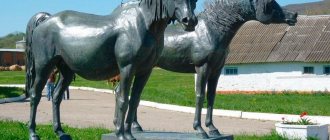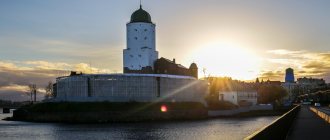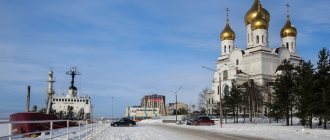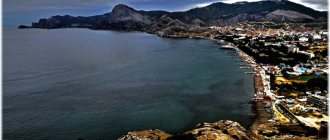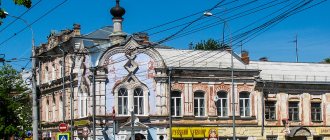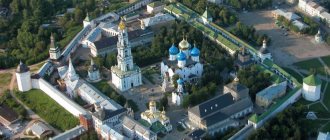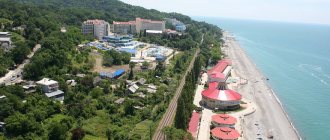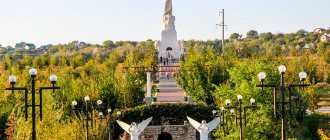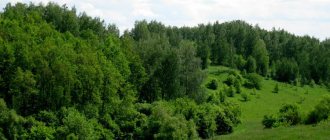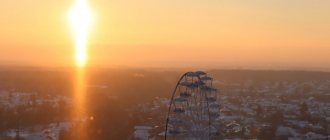Countries > Russia
Ivanovo is part of the Golden Ring with ancient churches, and the site of the establishment of the First Council after the revolution, and the textile industry, and the cultural center of the region. Here everything is mixed and reflected in the variety of architectural styles, where one street can remind of all historical periods at once. What you need to visit during your visit and where to take a walk are in this post.
- Sights of Ivanovo
- Monuments of Constructivism
- Museums
- How to get there
- Map
In the center
Shchudrovskaya tent
The oldest building in the city is a small one-story building, which stands out primarily because it does not fit into the modern urban landscape at all. Meanwhile, this is a unique building that has been preserved since the 17th century - the Shchudrovskaya Tent. There are few such buildings left in Central Russia, and it is they that give an idea of the features and peculiarities of ancient Russian architecture.
It was once the manager's house and the largest building of the settlement - at that time a settlement. Later it was bought by the merchant Shchudrov, in whose honor it received its current name. He placed a manufactory here. Then for many years it was used as a warehouse and miraculously retained its original appearance. Now it houses a branch of the local history museum, where you can learn more about the history of the tent and what used to surround it. The Shchudrovskaya tent is surrounded by modern buildings and busy streets and best represents the contrast of how much Ivanovo has changed.
st. August 10, 36A
Transfiguration Cathedral
The cathedral, also called the White Church, was built in the Russian style in the 19th century and is one of the rare surviving pre-revolutionary Ivanovo cathedrals. Unfortunately, the interiors and interior decor were destroyed during Soviet times, but the architectural complex has survived to this day.
Unlike other religious buildings, it was restored in the post-war period and was in operation even during the Soviet period. Believers visit the cathedral for the icon of the Mother of God and the relics of St. Basil.
st. Kolotilova, 44
Working hours: 08:00-18:00
Wiki/Commons
Dühringer Manor
This estate is one of the rare architectural monuments dating back to the pre-revolutionary era. An unusual mansion in the Art Nouveau style, reminiscent of a medieval castle, was built for the Swiss Dühringer, who worked in Ivanovo with the chintz industry. Since the owner of the mansion committed suicide, and all his heirs were subsequently repressed, the estate was shrouded in numerous legends. For example, that there is still a treasure chest inside. The spread of legends was partly facilitated by the non-standard appearance of the mansion. For many years, the estate was occupied by communal apartments; it was not restored and is now not in the best condition.
st. Maria Ryabinina, 33/28
Vvedensky Monastery
The monastery was formed quite recently - in 1991 - around a church that was built at the beginning of the 20th century. Almost immediately after its opening, it was converted into a KGB archive, since after the revolution all religious institutions were closed. Most of the interior and adjacent rooms have been rebuilt, but now they have been restored to their original historical appearance. The Vvedenskaya Church is one of the few in Ivanovo that managed to survive widespread demolition in the 1920s as part of the Soviet anti-church campaign. The historical environment has also not been preserved, so now the monastery is surrounded by panel houses.
st. Basic, 23
Working hours: 06:30-20:00
Estate of the Gandurin brothers
The Gandurin brothers stood at the origins of the creation of a textile manufactory, which later became famous throughout Russia. It is surprising that an entire architectural complex has been preserved: the estate of the brothers themselves, and behind it a former calico printing factory. The neat two-story house facing 10 Augusta Street is a typical example of noble buildings of the 19th century, of which, unfortunately, not many have survived here.
st. August 10, 31
Lenin Avenue
The main street practically crosses the city and personifies the variety of architectural styles that were layered on top of each other with the advent of a new historical era. In the center there are merchant mansions of the 19th and early 20th centuries, a little further there are constructivist post-revolutionary buildings and glass shopping centers of the 2000s. While walking along the avenue there will be a lot of interesting things: Pushkin Square, monuments, the Uvod River, churches and museums. There are also many cafes, restaurants and shops concentrated on it.
Uvod River
The avenue crosses the Uvod River, along which there is an embankment and a park with entertainment and attractions where you can go with your children. At sunset, this is one of the most picturesque places in the city. On the banks of the river there are several factories, including a textile factory, which previously used Uvod as a waste dumping site.
Textile factory
Ivanovo is famous for its textile industry, and in a sense, it became the city-forming enterprise. Production began in the 18th century and grew more and more over the years, forming around itself more and more settlements where workers and their families lived. As a result, several settlements united and created Ivanovo-Voznesensk. Textile enterprises experienced their peak at the end of the 19th century, but even now it is an important industrial area for the region, and Ivanovo textile products are sold throughout Russia. The textile factory has been preserved and still operates for its original purpose. It is visible from the side from the Uvodi embankment or Lenin Avenue.
Revolution square
Throughout history, Revolution Square has been an urban center: in pre-revolutionary Russia it was a commercial center, and in Soviet Russia it was an administrative center. Here is a monument to the fighters of the revolution in memory of those who spoke at the anti-government demonstration in 1915. The demonstration was brutally suppressed, as a result of which about a hundred people died. The sculptural composition, installed in 1975, depicts a worker who picks up the banner from his fallen comrade.
Several years ago, next to the monument, a church lost during Soviet times was restored. In general, the city is actively engaged in the restoration of churches that were previously demolished as part of the anti-church campaign.
Square of victory
In the center of another square - Victory - there is a monument to St. George the Victorious and a church in his honor. The square is interesting because it is surrounded by several constructivist buildings. Constructivism makes Ivanovo a truly interesting direction, because it was here that this style gained its greatest scope, the most daring experiments were carried out here, many of which have survived to this day.
State Medical Academy
The main monument of Stalinist neoclassicism is now occupied by the Medical Academy. This is a monumental building with many decorative elements: columns with the Corinthian order, obelisks, vases. Work on the project lasted for more than fifteen years, during which it became increasingly more complex and acquired new details. As a result, the decor came out somewhat overloaded, and the multi-tiered structure of the building also raises questions from a compositional point of view. Nevertheless, this is an unusual monument of the era.
Sheremetevsky Ave., 8
Stepanova Park
The largest city park, which is perfect for quiet walks or relaxing in nature. The park will also be interesting for children, as there are rides, a Ferris wheel, a boat station and rental points. In 1959, a hoe from the Mesolithic times, as well as a tip from the Neolithic times, were accidentally discovered in the park.
Shchudrovskaya tent
One of the symbols of Ivanov is the so-called Shchudrovskaya tent. This small brick building (the oldest surviving one) is one of the few architectural monuments of Pre-Petrine Rus' that the city can boast of.
Shchudrovskaya tent
The tent had a civilian and very prosaic purpose. It was built as an official hut for the village manager and was a kind of administrative center for the possessions of the Cherkasy princes. The tent contained only two rooms: one was the clerk’s office, the other was the village archive. Later (at the beginning of the 19th century) the owner of the building changed: the premises passed into the hands of the merchant Osip Shchudrov (from whom the monument received its current name) and underwent reconstruction. The enterprising new owner added two floors and organized a printing factory here.
In this form, the tent existed for almost 250 years, it was used as a residential building, a warehouse, and was rented out for production. In 1964, the Ivanov administration decided to return the historical building to its original appearance - the restoration lasted more than twenty years. True, as a result, the red brick walls were whitewashed and acquired a significant resemblance to the ancient white-stone fortresses that can be seen in Pskov. Now the Shchudrovskaya tent is under the jurisdiction of the Ivanovo Museum of History and Local Lore. D. G. Burylina. By the way, on the way to the architectural monument there is an art square, known in the city as a place of attraction for talented artists and craftsmen. Here they gather all year round and show everyone their work.
- Address: st. August 10, 36 A.
- Visiting hours: around the clock.
Excursions
Despite the fact that at first it may seem that Ivanovo is not that big, there are quite a lot of interesting points here. Each historical era has left its mark on the multifaceted appearance of the city.
For example, I had to prepare for the trip for quite a long time in order to have time to visit the most significant historical and architectural monuments of each period. And during the visit, it was necessary to use public transport more than once in order to get to another area in time - and still it was not possible to see everything that was planned.
If you also don’t have much time, I advise you not to repeat my mistakes and book an individual excursion in advance. Modern excursions are not at all boring academic stories in a large group, where you can barely hear the guide. This is a dynamic walk around the city with a local who will guide you to the best places along the optimal route. Although in Ivanovo it is even better to choose a guide with a car, this will give you the opportunity to visit everything at once and even drive into the surrounding area. You can choose an excursion on the trusted resource Tripster - there are walks with professional guides and informal tours.
The bride's crystal slipper
Of course, Ivanovo is best known as the “city of brides,” and, paying tribute to this glory, the townspeople placed a three-meter glass slipper in front of the building of the Chemical Technology University.
The bride's crystal slipper
Ivanovo residents owe the appearance of this structure to one of the city’s shopping centers. The grand opening took place in 2014 with the participation of numerous brides trying to “try on” the shoe one after another. The symbolic sculpture is multifunctional: it is an art object, a light installation, and a cascading flowerbed. Since its appearance, the “crystal slipper” has become one of the most interesting monuments of the city and has become popular among guests and local residents. Of course, an important factor is the location in the central part of the city, next to numerous parks and squares, which you can look into along the way and get acquainted with other interesting city sculptures.
- Address: Sheremetyevsky Avenue, 10.
- Visiting hours: around the clock.
Monuments of Constructivism
Since the first Council was created in Ivanovo, it was considered one of the key cities of the USSR. Therefore, it was here that it was decided to implement ambitious plans to create residential complexes that correspond to socialist ideas. Residential buildings had a special layout that provided common amenities for all residents, such as dining rooms, bathrooms, libraries, and leisure areas. Administrative and cultural institutions were designed with the strict functionality of each room.
In the 1930s, cultural centers, theaters, cinemas, factories and entire residential areas were actively built in constructivist and avant-garde styles. Characteristic features of the Ivanovo style were the use of red brick and walls imitating reinforced concrete, multi-stage structure and contrast of volumes.
Horseshoe house
One of the most famous constructivist landmarks is the horseshoe house. The townspeople called it a horseshoe for its shape after construction was completed - the architects did not think of such a similarity. The semicircular shape forms a courtyard, and the façade is notable for its triangular balconies. The complex was built as housing for political workers. Now it is a residential building. There is a legend that it is connected by an underground passage with the Bullet House (Lenin Ave., 37), which belonged to the NKVD.
st. Gromoboya, 13
House of the Collective
The residential complex was conceived as a communal house, where all household and social spaces would be common: a dining room, a kindergarten, an entertainment club. During construction, the community of buildings provided by the transitions was broken, and each building became isolated. Despite the fact that this is one of the best Ivanovo architectural monuments, it has never been reconstructed and is now in unsatisfactory condition.
As in other communal houses, the common spaces were subsequently reorganized and rebuilt. The common areas were used only for the first few years, and gradually the layout of each apartment changed: everyone had their own bathroom and kitchen.
st. Krasnykh Zori, 1
House-ship
From above, the shape of the house resembles a ship, which is why it got its name. It consists of two buildings, one of which was intended for the nomenklatura, and the other for workers. It contains constructivist elements: corner balconies, contrast of volumes, continuous glazing, stepped design. Unfortunately, the building has hardly been restored and is now not in the best condition.
Lenin Ave., 49
City Council House
The first apartment building in the city. It consists of several buildings of different heights. There are also characteristic corner balconies, many of which are now glazed, round windows, asymmetrical shapes.
Lenin Ave., 23
School No. 32
An innovative feature here is the observatory on the school tower, which is now, unfortunately, not in use. From above, the structure resembles a bird, which is why it is sometimes called a bird house.
Lenin Ave., 53
Cinema Sovremennik
Brutalist rough facade, decorated with Soviet symbols and a preserved sign in a characteristic Soviet font. Unfortunately, the building has ceased to be used as a cinema, and now part of the premises is occupied by shops, while the other part is not used.
Sheremetevsky Ave., 85
Hotel "Central"
An expressive example of style, thanks to an extraordinary approach with corner elements. The contrast of strict vertical and horizontal lines and colors is also striking.
Sheremetevsky Ave., 1
Ivselbank
One of the most recognizable elements of constructivism is the semicircular volume hanging over the entrance, in this case a flight of stairs. There are other classic style techniques here: dense glazing, contrast of geometric shapes, horizontal and vertical lines, flat roof.
st. Red Army, 10
Railway station
In 2022, the main station was restored in a constructivist style. This is a rare example of the complete restoration of an architectural monument of those years and the recreation of its original appearance. During the restoration, attention was paid to both the facade and interior details: mosaic panels, tiles, windows, columns, and benches were restored. At the same time, its infrastructure was modernized, the foundation was strengthened and ramps were installed.
The station is divided into blue and red halls. The main one is blue, here it is worth considering the restored mosaic panels on a revolutionary and industrial theme. A loom was installed in the middle of the hall - a symbol of Ivanov.
Vokzalnaya Square, 3
Ivanovo is a truly unique place where so many innovative architectural ideas have been implemented. Unfortunately, most architectural monuments are not in the best condition or even in disrepair, and many are used for other purposes. The former beauty can only be judged by historical photographs and design illustrations, but even now they surprise with their non-standard approaches and bold technical implementation.
Transfiguration Cathedral
The Transfiguration Cathedral is one of the oldest preserved in Ivanovo; this is an example of the revival of Russian architecture of the pre-Petrine era, which had particular success at the end of the 19th century. The construction of the temple took place between 1889 and 1893; it was carried out with the money of the manufacturer M. N. Garelin. This elegant church, which received the nickname “White” from the residents, initially belonged to one of the surrounding villages, and became part of the city only in 1917. The Soviet government closed the temple in 1940 and completely destroyed the interior decoration.
Transfiguration Cathedral
The reconstruction of the premises took place at the end of the Great Patriotic War: numerous requests from citizens had an effect. For a long time, the Transfiguration Church remained the only one in the entire region and had the status of a cathedral. Restoration work revived the previous interiors: the wall paintings were updated and the necessary utensils were purchased. An interesting fact is connected with the iconostasis: it was brought to the church being restored from the village of Sarajevo - three-tiered, gilded, carved, in the Baroque style, which also belonged to A.V. Suvorov.
Now the Transfiguration Cathedral is still active, although it transferred the powers of the cathedral to the Assumption Church. Among its shrines are the icon of the Mother of God “The Inexhaustible Chalice” and the relics of St. Basil (Preobrazhensky).
- Address: st. Kolotilova, 44.
- Opening hours: daily from 8:00 to 18:30.
Museums
Museum of the First Council
It will be interesting to learn about the revolution in Ivanovo and what place the city occupied in the history of the country at that time in the museum of the first Soviet. In addition, the pre- and post-revolutionary eras are compared here from the point of view of everyday life. The first Workers' Council was actually created in the building itself, then the first public council met, and then the Meshchanskaya Council.
Wiki/Commons
Sovetskaya st., 27
Working hours: 11:00-17:00
Entrance: 110 rubles, discounts available
Museum of Industry and Art
The museum is housed in a beautiful neoclassical building and contains exhibits from various noble collections, covering the period from antiquity to the early 20th century. It appeared thanks to the collector Burylin, who collected an impressive collection of art objects. By the way, in the Burylin mansion there is now a museum of Ivanovo chintz, and an underground tunnel has been laid between these buildings.
During Soviet times it was nationalized, and many exhibits were lost, but now the exhibition has been restored and restored.
st. Baturina, 6/40
Working hours: 11:00-17:00
Entrance: 120 rubles, discounts available
Museum of Ivanovo chintz
The exhibition consists of unique examples of textile craftsmanship and will be of interest to anyone who wants to look at chintz products and learn more about it as a decorative and applied art and one of the important folk traditions of this region.
st. Baturina, 11/42
Working hours: 11:00-17:00
Entrance: 120 rubles, discounts available
Museum of the Soviet Automotive Industry
The museum will be of interest to fans of Soviet cars. The exhibition appeared thanks to an automobile repair plant that was engaged in the restoration and restoration of historical cars. Now there are Volgas, Chaikas, cars belonging to both officials and ordinary people.
st. Paris Commune, 16
Working hours: 12:00-18:00
Entrance: 200 rubles, there are discounts
Uvodi embankment
Ivanovo, as expected, stands on the river, and the embankment is one of the popular and sought-after places for walks and entertainment. The Byway flows through the entire city; in its central part, the shore is landscaped: between the Teatralny and Sokovsky bridges, squares and parks are laid out, attractions are installed, there is a special area for skateboarding and an equipment rental point.
Uvodi embankment
Ivanovo is an industrial city, which is why many plants and factories were located near the river, using it as a place to dump waste, so there was never any need to talk about cleanliness. Now the situation has improved somewhat, but still there are not many people who want to swim in Uvodi. But here there are ducks and seagulls that you can feed (which especially attracts children), and the factory buildings along the banks, most of which have been preserved, form the unique appearance of the embankment.
- Address: embankment of the Uvodi River.
- Visiting hours: around the clock.
Let's sum it up
Unique museums with rich collections of rarities and antiquities and works of local folk crafts. Amazing architectural monuments: from Pre-Petrine Rus' to the Soviet avant-garde. Grandiose memorials and unusual monuments of modern times.
All this is Ivanovo, which is always ready to surprise its guests. You can and should come here for new impressions, mysterious legends, and a breath of history. This city is at the crossroads of eras; it contains a mixture of many different things: modernity, the conquests of the proletariat, folk crafts and ancient art. Everyone will choose what they like.
Red Talca
Another important memorial in the history of the proletarian movement of Ivanovo-Voznesensk is the so-called Red Talka. At the end of the 19th and beginning of the 20th centuries, rallies and meetings of workers from local textile factories were buzzing and seething in this very place. The first monument in honor of those events appeared in 1957: a brick obelisk with an appropriate inscription. However, during the required reconstruction, it was completely rebuilt and received its current appearance. The new monument was opened in 1975. The authors of the composition are sculptor L. L. Mikhailyonok and architect V. S. Vasilkovsky.
Red Talca
Today, the memorial is an organic ensemble of several elements. The entrance to it is decorated with a small platform, which continues with a wide and long alley of heroes. At the beginning of it there is a monument to the Bolshevik Fyodor Afanasyev, who died on this place, and then on both sides there are busts of revolutionaries who took an active part in the First Russian Revolution. The compositional center of the memorial is an obelisk monument on a round platform, slightly elevated above the ground, in front of it is a bowl of eternal flame, now extinguished. In general, having lost its ideological significance, the “Red Talka” memorial has also lost state support, and therefore is in disrepair.
- Address: near the intersection of Shuvandina and Svoboda streets.
- Visiting hours: around the clock.

